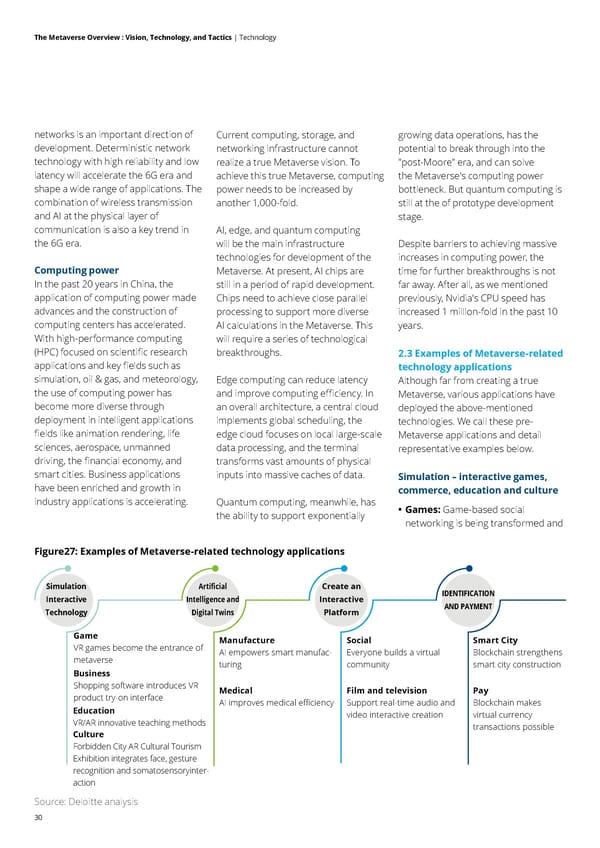30 The Metaverse Overview : Vision, Technology, and Tactics | Technology networks is an important direction of development. Deterministic network technology with high reliability and low latency will accelerate the 6G era and shape a wide range of applications. The combination of wireless transmission and AI at the physical layer of communication is also a key trend in the 6G era. Computing power In the past 20 years in China, the application of computing power made advances and the construction of computing centers has accelerated. With high-performance computing (HPC) focused on scientific research applications and key fields such as simulation, oil & gas, and meteorology, the use of computing power has become more diverse through deployment in intelligent applications fields like animation rendering, life sciences, aerospace, unmanned driving, the financial economy, and smart cities. Business applications have been enriched and growth in industry applications is accelerating. Current computing, storage, and networking infrastructure cannot realize a true Metaverse vision. To achieve this true Metaverse, computing power needs to be increased by another 1,000-fold. AI, edge, and quantum computing will be the main infrastructure technologies for development of the Metaverse. At present, AI chips are still in a period of rapid development. Chips need to achieve close parallel processing to support more diverse AI calculations in the Metaverse. This will require a series of technological breakthroughs. Edge computing can reduce latency and improve computing efficiency. In an overall architecture, a central cloud implements global scheduling, the edge cloud focuses on local large-scale data processing, and the terminal transforms vast amounts of physical inputs into massive caches of data. Quantum computing, meanwhile, has the ability to support exponentially growing data operations, has the potential to break through into the "post-Moore" era, and can solve the Metaverse's computing power bottleneck. But quantum computing is still at the of prototype development stage. Despite barriers to achieving massive increases in computing power, the time for further breakthroughs is not far away. After all, as we mentioned previously, Nvidia's CPU speed has increased 1 million-fold in the past 10 years. 2.3 Examples of Metaverse-related technology applications Although far from creating a true Metaverse, various applications have deployed the above-mentioned technologies. We call these pre- Metaverse applications and detail representative examples below. Simulation – interactive games, commerce, education and culture • Games: Game-based social networking is being transformed and Figure27: Examples of Metaverse-related technology applications Source: Deloitte analysis Game VR games become the entrance of metaverse Business Shopping software introduces VR product try-on interface Manufacture AI empowers smart manufac- turing Medical AI improves medical efficiency Social Everyone builds a virtual community Film and television Support real-time audio and video interactive creation Smart City Blockchain strengthens smart city construction Pay Blockchain makes virtual currency transactions possible Education VR/AR innovative teaching methods Simulation Interactive Technology Artificial Intelligence and Digital Twins Create an Interactive Platform IDENTIFICATION AND PAYMENT Culture Forbidden City AR Cultural Tourism Exhibition integrates face, gesture recognition and somatosensoryinter- action
 Deloitte The Metaverse Overview Page 29 Page 31
Deloitte The Metaverse Overview Page 29 Page 31